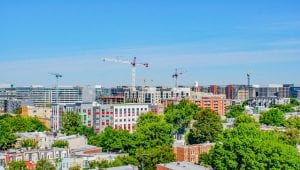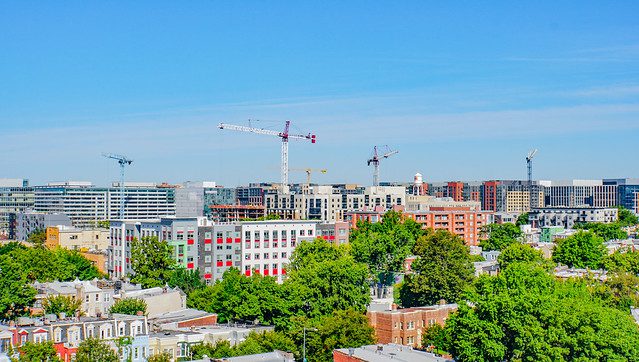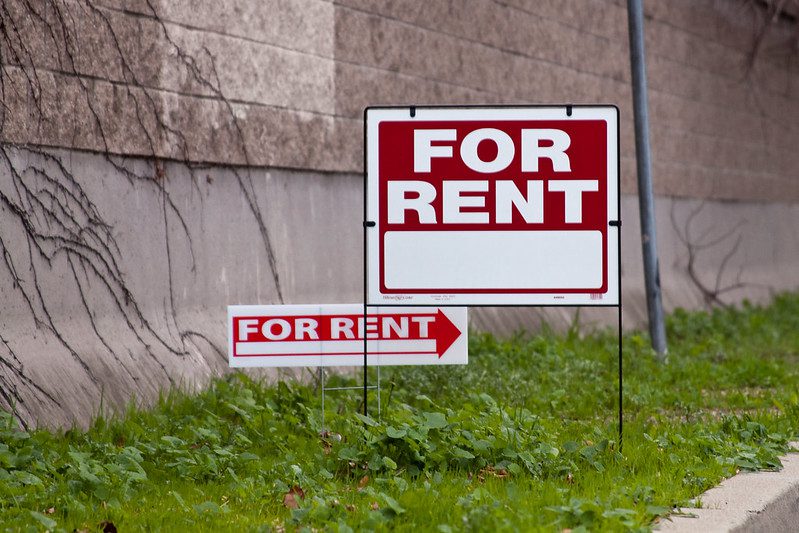
Views of Washington D.C.’s H Street, NE, nearly 50 years after it was destroyed in riots following the assassination of Martin Luther King, Jr. Photo by Ted Eytan via flickr, CC BY-SA 2.0
The National Community Reinvestment Coalition (NCRC) released a report on gentrification, Shifting Neighborhoods: Gentrification and Cultural Displacement in American Cities, in March, and its findings, especially on the rapid rate of gentrification in Washington, D.C., made a big splash. Other portions of the report, including what they found about racial displacement in gentrifying areas, got less attention. Measuring both gentrification and displacement can be very tricky, as we discussed in our researcher roundtable earlier this year. So we sat down with Bruce Mitchell, NCRC senior research analysis, to hear more about what their findings show or don’t show, how they’re thinking about the findings, and what the policy implications might be.
Miriam Axel-Lute: Why did NCRC decide to do research on gentrification now?
Bruce Mitchell: We’re an organization [with] around 600 local members, primarily focused on the Community Reinvestment Act. We were hearing about this a lot from our member base, the feeling that their communities were being really severely altered and were somehow no longer their communities. We wanted to see how extensive gentrification was and whether displacement was also occurring connected with the gentrification that our members were talking to us about.
How do you think your findings matched up with what people are experiencing on the ground?
They both matched and didn’t match. They matched in the sense that where we found gentrification occurring, it could be quite intensive, particularly in Washington, D.C. It was very apparent to us on the ground how you had this cultural transformation taking place along with gentrification in many neighborhoods in Washington, D.C.
[RELATED ARTICLE: What Does ‘Gentrification’ Really Mean?]
So, in a sense, yes, we validated our members’ perceptions on that, but the other thing we found was that gentrification is kind of rare, and displacement is kind of rare; 76 percent of the urban areas that we examined did not show indications of gentrification, out of 935 cities that we looked at.
So, are folks experiencing either fear of displacement and gentrification, or perception of it, in places where your numbers didn’t show that it was happening?
We partnered with several different groups in cities that all had some intensity of gentrification and displacement taking place. Our community partners wrote a separate piece about their perceptions of what was happening within their communities regarding gentrification [See “Local View” links at the study’s main page], and also some ideas about what could be done so that gentrification doesn’t lead to complete displacement, but can lead to people actually enjoying the benefits of revitalization within their communities rather than being pushed out of them.
What are the policy implications of what you found for the places where gentrification is rare or not happening?
Our study indicated that while gentrification was rare, with 76 percent of urban areas unaffected, there is a broad problem of disinvestment and decline, as is highlighted in a recent University of Minnesota study. They found that the most common problem for American neighborhoods is concentration of poverty, and generally residents are more exposed to decline than gentrification. These cities and neighborhoods are in desperate need of reinvestment and revitalization.
While gentrification and displacement are occurring in a concentrated way in some cities, many more suffer from economic stagnation and disinvestment. Some cities, like Baltimore, are impacted both by gentrification and concentrated poverty.
Policies like CRA are useful for communities where you have large numbers of low- to moderate-income families. We would like to see a more vigorous application of the Community Reinvestment Act for those communities. And in the communities where gentrification and displacement is taking place, we’d also like to see CRA and local policies work in tandem to try to make the benefits of revitalization be more evenly distributed.
It seems that perhaps for many of us in the field the surprising part of your research was that part where gentrification was not so widespread and that, even where it was happening, that cultural displacement was only happening in 22 percent of the cases. That seems like the surprising part of your research, and yet that’s not what’s being focused on in the media coverage of it. Can you talk a little bit about that tension?
We tried to follow standard methodology that’s been applied in the past, primarily from Lance Freeman’s work at Columbia University and [the] Governing [study]. They applied a very similar methodology, which we tried to adhere to so we could have validation. [Governing] only did their study on 50 cities, and we wanted to get a nationwide perspective.
Additionally, in terms of validation, we passed a lot of the maps on to members so they could vet them and see if they corresponded with what they were seeing on the ground.
Some cities actually have gentrification and displacement, taking place at the same time that concentrated poverty is occurring. An example of that might be Baltimore, where you see this spreading of gentrification from the Inner Harbor area, ever since the Inner Harbor was revitalized. By the same token, there are many neighborhoods in Baltimore that are left out and are not experiencing this kind of revitalization, and may indeed be experiencing concentrated poverty also.
There was a study just published by the University of Minnesota, where they’re looking at both the concentration of poverty and the displacement of lower-income residents. Our studies complement each other quite well. Their study goes a little bit beyond ours in looking at the concentration of poverty. Oftentimes this is happening in inner-ring suburbs, where you have aging housing stock and this re-concentration of low-income people as they’re being pushed out of the central business district of cities.
Is it a policy problem to assume that every neighborhood is at risk of both gentrification and cultural displacement?
Policies need to come mostly from the local level. Of course, federal financing and funding is very necessary, but solutions need to come from the residents at the local level of their cities. We have several policy recommendations that can lessen the impact of displacement while preserving some of the benefits of revitalization, things like the right of first refusal, and assistance in terms of downpayment for low-income households or first-time buyers. Developers should be working more intensively with community groups in their cities to make sure that sufficient affordable housing is constructed in areas where there’s a high potential for displacement.
In Washington, D.C., some of the highest displacement that our partner group, Empower D.C., is seeing is [in] areas [where there] are public housing projects that are being, in essence, converted into upper-income type areas. The desire, of course, is mixed-income areas, but there’s this feeling with local groups that there’s insufficient affordable housing being provided, and there’s a disruption of community that takes place as a result, where communities that had been in place for decades are basically uprooted and scattered about. So, there’s this loss of community and services to people living in low-income areas and in public housing areas.
I was wondering about strategies like inclusionary housing that are most appropriate in a place that’s a strong market, (or need to be approached differently in a different market at least), but sometimes, people try to apply it to a place where there isn’t that pressure yet, and it may distract from policies of investment that those areas need.
Yes. If an area’s not experiencing displacement, then it has another set of problems to deal with.
I think many of us were surprised to see that the number you found for racial displacement was as low as 22 percent of gentrifying tracts. What were your reactions and your members’ reactions to that finding?
Well, we’re limited by our methods somewhat, right? The timeframe we were looking at was between 2000 and 2010–2013. Displacement can sometimes take place before gentrification starts occurring—you have a general disinvestment, a general loss of population within a neighborhood—or it can actually take place after the gentrification process has started. So, our concern is that many of the neighborhoods that were indicated as being gentrified in our study may be in the process of having [racial] displacement unfold.
My hope is that we’ll look at the 2020 Census and be able to better judge what’s happening in those neighborhoods. We found there’s more integration taking place in neighborhoods that are gentrifying. Our concern is that these integrated neighborhoods may be moving back towards re-segregation, and that’s something that we may not be able to tell until after the initial gentrifications take place, because gentrification is a process that can take sometimes a decade or more to unfold.
What makes you fear that they’re moving back towards segregation?
It’s mainly what we’re hearing from members on the ground.
Asian-American displacement from Chinatown in D.C. didn’t register in your methodology. Was that a time-frame thing also?
It very well could be.
There’s also gentrification of businesses, too, and that’s something [that]we could not tackle in the study. That’s where the type and nature of businesses within a neighborhood can change. Chinatown is a very commercial district.
Do you feel like the media coverage of your report caught the key essence of what you were trying to get out there?
Yes. I think it has, for the most part. Any study is somewhat bound by its methods. We were real interested in capturing this issue of displacement, because a lot of studies in the past have not. Displacement has mainly been measured through looking at rates of residential mobility. Studies in the past did not reflect the same levels of displacement that [ours] did. So, there’s been kind of a mixed bag in terms of the research on displacement and whether it’s occurring or isn’t.
In your literature discussion you pointed out that there’s high turnover in disinvested areas as well. Low-income people move frequently. Often they’re living in poor conditions, and that prompts or forces them to move. If folks in a given place are moving frequently because of poor conditions, and then those conditions improve, you would actually expect to see their mobility rate go down, wouldn’t you? So, if it just holds steady, that actually is indicative of displacement.
The Fed[eral Reserve] study on this in Philadelphia in 2016 looked at mobility rates. They found comparable mobility rates in both gentrifying tracts and in tracts that were not gentrifying. But while the rates of mobility are similar, low-income people moving into tracts that have gentrified is what’s not occurring. They move out at similar rates, at least in that study, but they don’t come back because of the loss of affordability.
But they shouldn’t even be moving out at the same rate they had been if the conditions have improved, because there shouldn’t be conditions driving them out. So it seems like comparable mobility rates indicate some displacement pressure to me.
Talk about the CRA connection. Many people think of CRA as something that’s supposed to be directing investment into places that aren’t getting investment. Gentrifying areas are getting investment—it’s a question of what kind of investment. How do you talk about that in relation to CRA?
We’re concerned that CRA be applied to low- to moderate-income borrowers. It’s not enough just to have lending in LMI [low- and moderate-income] tracts, the rate of lending to LMI borrowers is also very important.
Are there parts of your study that either surprised you or you thought were really important that you’d like people to be paying more attention to?
I wasn’t really surprised that gentrification was occurring most in the nation’s biggest cities, because they simply have more tracts. I wasn’t surprised that gentrification is taking place in some of the most economically vital cities throughout the United States. I was a little bit surprised about the findings on Baltimore and Philadelphia, because those cities have very high rates of poverty. That was somewhat surprising.
Another surprising thing about Baltimore was there were actually some areas where we saw white displacement taking place, white displacement and low-income displacement.
Gentrification has both benefits and problems associated with it. The revitalization that comes from gentrification can certainly benefit communities. It can certainly benefit cities as a whole, as they have a rising tax base, they’re able to provide better services to their citizens and residents. Our concern is that the incumbent residents be able to benefit from revitalization and not be pushed out of the urban structure and no longer be able to participate [in] the revitalization of their neighborhoods or cities. So, we’re very concerned to see that integrated neighborhoods, both in the sense of racially integrated, ethnically integrated, and economically integrated, be supported.
There are a lot of people who define gentrification as revitalization that includes displacement. From this perspective, if it doesn’t include displacement, it’s not gentrification, it’s equitable redevelopment. The terminology can be very loaded. Talk about your language choices, how you use “gentrification,” “displacement,” and “cultural displacement,” and why.
Initially, [when] Ruth Glass [was] writing about this phenomena in London back in the 1960s, it involved a degree of displacement of lower-income people in London’s neighborhoods. So, the original definition of gentrification does indicate that you have a class transition taking place within a neighborhood.
We’ve tried to [talk about] gentrification without displacement as being more revitalization. But yes, gentrification is a loaded term. And it does seem to indicate that there is at least some form of pushing out incumbent residents from a neighborhood.
What NCRC as an organization wants to see is revitalization taking place in neighborhoods, and also that neighborhoods become places where people with low incomes, all races, can enjoy the benefits of the city.
And yet technically, the definition that you used for gentrification wouldn’t necessarily imply displacement if the overall population was rising. If overall income was rising, but nobody was leaving . . .
Yes, that’s true, if the population in the neighborhood actually increases. Oftentimes, though, before gentrification occurs, you have population decline that comes as a result of disinvestment and general dilapidation and loss of infrastructure within a neighborhood. So, oftentimes, displacement and disinvestment become preconditions to a later gentrification occurring.
Thank you.





Thank you Miriam for trying to give fair representation of all the major viewpoints and concerns about gentrification and displacement in this interview. I think this correctly frames the policy debate in terms of two open questions. One, what do the majority of urban Census tracts that are not experiencing gentrification and displacement actually need in terms of investment that will increase quality of life and opportunity for their residents? Two, what interventions can be implemented in gentrifying areas to actually lower the rate of outward mobility of existing populations? It seems clear that significant investments in preserving and producing affordable housing have to be centered in the conversation.
In Greensboro, NC, it is gentrification by force as Andrew Swofford and the corrupt Greensboro Police Department teamed-up and ganged-up on a campaign against me a lot of people are actually comfortable with but I’m not so the Department began coming out to Catawba County, too. What the Department although it was not all of them just the most of them and in the long run all of them–what the city does is go on slander and hounding campaigns with help from city officials, cops like Wingfield, Counts, Miller who should have done more, Izaguirre who cited me for “Injury to Personal Property” after going after people who kept coming to me: the Westerwood Neighborhood Association all of whom were white save one and Swofford was saved by his skin, too.
I watched Swofford for years get deeper and deeper into the drug game thanks to Community Watch Gail Barger who I notified not only of Swofford but his future I was way off about, my prediction coming long before the Web: “Someday that kid is going to make his parents famous.” But that was long before Google Swofford becoming “Westerwood’s” Keith Richards thanks to his personal connections with both the City of Greensboro and eventually the corrupt Greensboro Police Department. Crazy, ain’t it–it sure is, I had one person after another coming to me or my property–stopped dead by Barnes’s people who did not have real estate and money on their minds like the city has if it thinks of anything else and the City of Greensboro was fully and entirely aware of sub-standard housing issues it didn’t give a flip about long ago. So, Swofford and CRO Ben Wingfield both teamed-up to jam me–that’s how corrupt the GPD is and if you think people don’t know this, everyone knows it. Getting out to see who it was idling behind me I saw it was “Clyde” who threw the family Volvo in reverse taking off down Mimosa Drive which is exactly what CRO Ben Wingfield did in his cruiser in Latham Park, the city lending time, money and equipment to what was essentially rich white people, who, thanks to everyone who knows it and both parties are fully aware come to you and/or your property repeatedly–all will be out to have you charged but they were nearly charged thanks to GCSO who told some handy-man I didn’t even know named Kim Maynard–nor did I know where he lived, county telling me Maynard would be “The last of these people that keep coming to you” which became a huge problem for the city whose attitude toward wealth and race has been clear for some time.
Everyone involved in this scam is white and despite never asking the city the personal finances of winners like Andrew Swofford, although I was not nearly the only one aware of how he spent his time, the city told me I “needed to understand that people with money run everything and always have” how it knew of my financial situation it has never told me, I’ve never told government how much I was worth but the city told me exactly how worthless I was by bailing-out Maynard, Community Watch Gail Barger who was served right in front of GCSO–and Andrew Swofford, too. Wow, Chief Hinson, you’re a piece of work and a hypocrite as usual for going to D.C. to gripe about opioids when you left Barger in the Community Watch Program and if you got her out of there like you said you would after I told you to people would actually have good things to say, even Zack Matheny would have given you some good marks but you went the way of finances, you left a convicted perjurer and an enabler to Andrew Swofford who now has a huge connection to you. You should have taken him to D.C. with you and dropped him off there; his life is over in Guilford County and now your reputation is worse if that’s even possible.
The GPD is so perturbed by my big mouth it began coming out to Catawba County, its biggest contact in Valley Hills Mall right up behind me with “YOU KNOW WHERE SECURITY’S AT” which was identical to how people like Andrew Swofford repeatedly contacted me–you can check Justin Outling’s record at the Bar. He knows all about what the GPD and Andrew Swofford did in his District and like many in Greensboro has known for years. It’s funny how people in law are like that but they often are.
Miriam — This is a great interview. As you know, most of the discussions about gentrification/displacement address the hot markets. But your discussion helped those of us in cool/disinvested markets like Memphis. Very useful. Thank you. Steve Lockwood, Frayser CDC